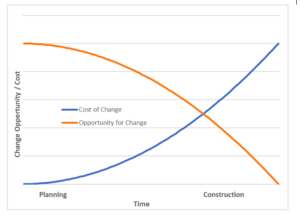What happens when your project has a fixed budget and an open-ended project scope? Or what if there is a desire to deal with not only a specific need, but also address a “wish list” of additional improvements?
 One benefit of progressive design-build project delivery is the collaborative approach to working through the design, evaluating value engineering options, and assessing constructability of a given project. This type of approach results in the opportunity to improve project costs and provide better cost certainty. The cost of change increases through the progression of a project (i.e., making changes and design decisions earlier in the project) are far more cost effective than implementing changes later (see graphic).
One benefit of progressive design-build project delivery is the collaborative approach to working through the design, evaluating value engineering options, and assessing constructability of a given project. This type of approach results in the opportunity to improve project costs and provide better cost certainty. The cost of change increases through the progression of a project (i.e., making changes and design decisions earlier in the project) are far more cost effective than implementing changes later (see graphic).
On projects where budget dictates opportunity to address wish-list items, a segmented approach to Phase 1 (preconstruction services) is a new approach that might benefit owners with limited budgets yet significant capital improvement needs. A segmented approach, while varying from industry standard practices for the entire Phase I preconstruction and design approach, may allow owners to further refine their needs and the overall scope of the project while adhering to budgetary constraints. Such a modified Phase 1 approach allows the owners and their design-build partner to evaluate options by collaboratively performing pilot tests, assessing ancillary scope, estimating costs, and developing priorities to ensure all of the work falls within a defined budget.
In implementing a segmented Phase 1 process, a client’s request for proposal (RFP) would include a base scope and a full list of additional improvements. By including the full wish list, competing design-build firms are provided a baseline to develop a Phase 1 fee for evaluation. This fee is presented in two components, Phase 1A and Phase 1B. Once a design-build firm is selected, a contract would be issued for the Phase 1A amount, allowing the collaborative process to commence. For a treatment facility, Phase 1A might include the following:
- Evaluating flows and loading
- Completing analysis of alternatives
- Assessing the condition of existing infrastructure
- Developing priorities – picking which wish-list items to include
- Undertaking surveying and geotechnical services
- Engaging with permitting agencies
- Drafting a basis of design report
- Developing a scope and price for Phase 1B that is indicative of the decisions made in Phase 1A
At the end of this initial phase, an amendment would be issued for Phase 1B. This phase might include the following:
- Developing 30% design
- Evaluating work sequencing and constructability
- Developing and updating a cost model
- Furthering design to 60% or 90% (depending on the client’s preference)
- Engaging the suppliers and subcontractors to solicit competitive pricing
- Developing a guaranteed price for Phase 2
With the client’s acceptance of the guaranteed price, a second amendment or additional contract for Phase 2 would be issued to complete design and construct the project.
The value of a segmented Phase 1 approach is determining which procurement and construction costs fit within a project budget. The process provides clarity and identifies priorities for execution. Ultimately this approach decreases Phase 1 cost as certain items are excluded from the project scope early in the process, eliminating what would have been payment for engineering assessments and designs for wish-list items that are never constructed.

